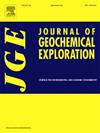Rb-Sr dating of pyrite, Zircon U-Pb geochronology, and Sr-Nd-Hf isotopic geochemistry of the Baiyun Au deposit in the Qingchengzi Orefield, Liaodong Peninsula, Northeast China
IF 3.3
2区 地球科学
Q1 GEOCHEMISTRY & GEOPHYSICS
引用次数: 0
Abstract
The Baiyun Au deposit (>20 t/5.86 g/t) is situated in the eastern Liaodong Peninsula.
(LP). More than 68 orebodies are found in the Precambrian metamorphic rocks and include altered rock type (ART) and quartz vein type (QVT). Pyrite Rb-Sr and zircon U-Pb dating, the elements and Sr-Nd-Hf isotopic geochemical data, and trace element contents of pyrite are adopted to control the ore genesis, petrogenesis, and the tectonic dynamics background of the Baiyun Au deposit. Isotopic chronology reveals that the magmatism can be divided into the Late Triassic (226–216 Ma), the Middle Jurassic (164.4 ± 0.4 Ma), and the Early Cretaceous (129.0–95.0 Ma). The 218.6 ± 0.4 Ma, which is obtained by pyrite Rb-Sr dating, represents the ore-forming age of the Baiyun Au deposit. Geochemically, the granite porphyry is enriched in K, Rb, and light rare earth elements (LREEs), and depleted in Nb, Ti, Ta, P, and heavy rare earth elements (HREEs), which belong to metaluminous adakite rocks. In addition, the initial 87Sr/86Sr ratios of the granite porphyry are between 0.71053 and 0.71141, the εNd(t) values and two-stage model ages (TDM2) of granite porphyry range from −17.9 to −17.1 and 2.458 to 2.387 Ga, respectively. Its εHf(t) values and TDM2 range from −14.46 to −12.48 and 2.159 to 2.054 Ga, respectively. Therefore, we proposed that the granite porphyry may be derived from ancient crustal sources. The quartz porphyry is enriched in Pb, K, Sr, and LREEs, and depleted in Ti, Nb, P, Ta, and HREEs, which belongs to the high-K Cal-alkaline and metaluminous to weakly peraluminous series. The initial 87Sr/86Sr ratios of quartz porphyry are between 0.71537 and 0.71690, εNd(t) values are between −17.1 and − 15.6, TDM2 values are between 2.405 Ga and 2.295 Ga, and its εHf(t) values range from −17.58 to −14.07, TDM2 ages range from 2.262 to 2.159 Ga, suggesting that the quartz porphyry mainly derived from ancient crustal sources. Three generations of pyrite (PyI, PyII, and PyIII) are identified. PyI and PyII occur in the first and second stages, respectively, and Py III occurs in schist (host strata). Py II has higher Au concentrations than Py I and Py III, indicating that gold is mainly deposited in the second stage. The pyrite has a medium-high proportion of Co and Ni, indicating a mixed fluid of magmatic water and other fluid origins. Combined with regional tectonic evolution, we classified the Baiyun Au deposit as a Late Triassic intrusion-related gold deposit. The Baiyun gold deposit and Late Triassic intrusions were formed during the Yangtze Craton (YC) subducted beneath the North China Craton (NCC). The rocks that formed during the Middle Jurassic and the Early-Late Cretaceous may be related to the subduction of the Paleo-Pacific Plate.

辽东半岛青城子矿田白云金矿黄铁矿Rb-Sr定年、锆石U-Pb年代学及Sr-Nd-Hf同位素地球化学
白云金矿床(> 20t /5.86 g/t)位于辽东半岛东部。在前寒武纪变质岩中发现68个矿体,包括蚀变岩型(ART)和石英脉型(QVT)。利用黄铁矿Rb-Sr和锆石U-Pb定年、元素和Sr-Nd-Hf同位素地球化学数据、黄铁矿微量元素含量等资料,控制白云金矿床的矿石成因、岩石成因及构造动力学背景。同位素年代学表明,岩浆活动可分为晚三叠世(226 ~ 216 Ma)、中侏罗世(164.4±0.4 Ma)和早白垩世(129.0 ~ 95.0 Ma)。黄铁矿Rb-Sr测年得到的成矿年龄为218.6±0.4 Ma,代表了白云金矿床的成矿年龄。地球化学上,花岗岩斑岩富集K、Rb、轻稀土元素(lree),贫Nb、Ti、Ta、P、重稀土元素(hree),属于铝质埃达岩。花岗岩斑岩初始87Sr/86Sr比值在0.71053 ~ 0.71141之间,εNd(t)值在- 17.9 ~ - 17.1之间,两阶段模式年龄(TDM2)在2.458 ~ 2.387 Ga之间。其εHf(t)值为- 14.46 ~ - 12.48 Ga, TDM2值为2.159 ~ 2.054 Ga。因此,我们认为花岗斑岩可能来源于古地壳。石英斑岩富集Pb、K、Sr、lree,亏缺Ti、Nb、P、Ta、hree,属于高钾钙碱性、弱过铝质系列。石英斑岩初始87Sr/86Sr比值在0.71537 ~ 0.71690之间,εNd(t)值在- 17.1 ~ - 15.6之间,TDM2值在2.405 ~ 2.295 Ga之间,εHf(t)值在- 17.58 ~ - 14.07之间,TDM2年龄在2.262 ~ 2.159 Ga之间,表明石英斑岩主要来源于古地壳。鉴定出三代黄铁矿(PyI、PyII和PyIII)。PyI和PyII分别赋存于第一阶段和第二阶段,pyiii赋存于片岩(寄主地层)中。pyii期金含量高于pyi和pyiii期,表明金主要在第二阶段沉积。黄铁矿Co、Ni含量中高,为岩浆水与其他流体的混合流体。结合区域构造演化,将白云金矿床划分为晚三叠世与侵入体有关的金矿床。白云金矿床和晚三叠世侵入体形成于华北克拉通下俯冲的扬子克拉通时期。中侏罗世和早晚白垩世形成的岩石可能与古太平洋板块的俯冲有关。
本文章由计算机程序翻译,如有差异,请以英文原文为准。
求助全文
约1分钟内获得全文
求助全文
来源期刊

Journal of Geochemical Exploration
地学-地球化学与地球物理
CiteScore
7.40
自引率
7.70%
发文量
148
审稿时长
8.1 months
期刊介绍:
Journal of Geochemical Exploration is mostly dedicated to publication of original studies in exploration and environmental geochemistry and related topics.
Contributions considered of prevalent interest for the journal include researches based on the application of innovative methods to:
define the genesis and the evolution of mineral deposits including transfer of elements in large-scale mineralized areas.
analyze complex systems at the boundaries between bio-geochemistry, metal transport and mineral accumulation.
evaluate effects of historical mining activities on the surface environment.
trace pollutant sources and define their fate and transport models in the near-surface and surface environments involving solid, fluid and aerial matrices.
assess and quantify natural and technogenic radioactivity in the environment.
determine geochemical anomalies and set baseline reference values using compositional data analysis, multivariate statistics and geo-spatial analysis.
assess the impacts of anthropogenic contamination on ecosystems and human health at local and regional scale to prioritize and classify risks through deterministic and stochastic approaches.
Papers dedicated to the presentation of newly developed methods in analytical geochemistry to be applied in the field or in laboratory are also within the topics of interest for the journal.
 求助内容:
求助内容: 应助结果提醒方式:
应助结果提醒方式:


